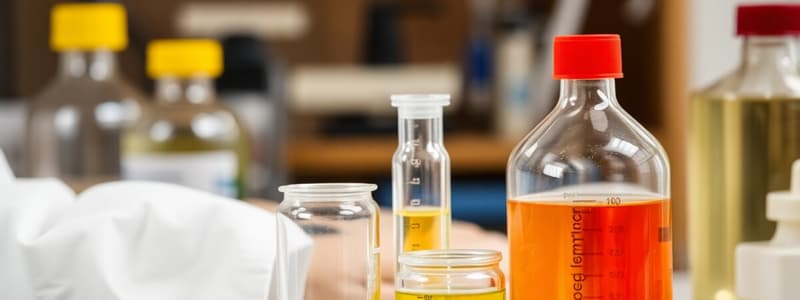Podcast
Questions and Answers
What is the definition of toxicology?
What is the definition of toxicology?
The study of the adverse effects of chemical or physical agents on living organisms.
Which area of toxicology is concerned with toxicity testing?
Which area of toxicology is concerned with toxicity testing?
- Mechanistic Toxicology
- Forensic Toxicology
- Regulatory Toxicology
- Descriptive Toxicology (correct)
What does regulatory toxicology focus on?
What does regulatory toxicology focus on?
- Diagnosis and management of diseases caused by toxins
- Determining if a drug has low risk for marketing (correct)
- Studying environmental pollutants
- Identification of toxic chemicals causing death
What is the role of the FDA in toxicology?
What is the role of the FDA in toxicology?
Match the following areas of toxicology with their descriptions:
Match the following areas of toxicology with their descriptions:
Which area of toxicology deals with the identification of toxic chemicals in biological samples?
Which area of toxicology deals with the identification of toxic chemicals in biological samples?
Risk assessment is the quantitative estimate of the potential hazards of ___________ on human health and environments.
Risk assessment is the quantitative estimate of the potential hazards of ___________ on human health and environments.
What is the first step in the risk assessment process?
What is the first step in the risk assessment process?
Which term describes the relationship between dose and adverse effects?
Which term describes the relationship between dose and adverse effects?
Flashcards are hidden until you start studying
Study Notes
Introduction to Toxicology
- Toxicology studies the adverse effects of chemical or physical agents on living organisms.
- It's a multidisciplinary field involving various sciences such as chemistry, biochemistry, pathology, and physiology to understand how substances cause toxic effects.
Different Areas of Toxicology
- Descriptive Toxicology focuses on toxicity testing in cell cultures and experimental animals. It provides information on the safety and toxicity of chemicals for humans and the environment.
- May be classified to study potential effects on humans (e.g., drugs and food additives) and other factors that can disrupt the environment (e.g., chemicals used by companies).
- Mechanistic Toxicology aims to identify and understand the biochemical and molecular mechanisms by which chemicals exert toxic effects.
- Regulatory Toxicology decides whether a drug or chemical is safe enough to be marketed based on data from descriptive or mechanistic toxicology.
- The Food and Drug Administration (FDA) is responsible for regulating drug, cosmetic, and food additives sold commercially.
- Forensic Toxicology focuses on identifying and studying toxic chemicals that cause death during postmortem investigations. Analysts use chemistry to identify toxic chemicals in biological samples.
- Clinical Toxicology diagnoses and manages diseases caused by toxins in poisoned patients.
- Environmental Toxicology studies the effect of chemical pollutants in the environment on living organisms, especially regarding industrial hygiene.
- Toxicogenomics (Genetic Toxicology) studies alterations in the genome of living cells in response to environmental toxins, including genotoxic carcinogens. It also explores how genetic polymorphisms (variations) can influence the detoxification of chemotherapeutic agents.
Risk Assessment
- Societies' dependence on chemicals necessitates the assessment of potential hazards. Toxicologists play a crucial role in the decision-making process.
- Risk assessment is a quantitative estimation of the potential hazards of chemical exposures to human health and environments.
- Examples include pesticide residues on food and contaminants in drinking water.
- Risk assessment involves four steps:
- Hazard identification: Determines if exposure to a substance causes adverse health effects. Identifies types of toxic effects (e.g., liver, kidney, nerve toxicity, birth defects, and cancer).
- Information can come from experimental studies (in vitro and in vivo analysis; toxicity testing) and epidemiological studies (observations of humans).
- Dose-response assessment: Establishes the quantitative relationship between the dose (amount of exposure) and the extent of the toxic response (adverse effects).
- NOAEL (No Observed Adverse Effect Level) and LOAEL (Lowest Observed Adverse Effect Level) are calculated in this step.
- Exposure assessment: Identifies the routes (oral, dermal, parenteral, inhalation) and duration (frequency of dose) of exposures to the substance in question.
- Risk characterization: Combines the information from the previous steps to determine the probability of adverse effects occurring.
- Hazard identification: Determines if exposure to a substance causes adverse health effects. Identifies types of toxic effects (e.g., liver, kidney, nerve toxicity, birth defects, and cancer).
Studying That Suits You
Use AI to generate personalized quizzes and flashcards to suit your learning preferences.




